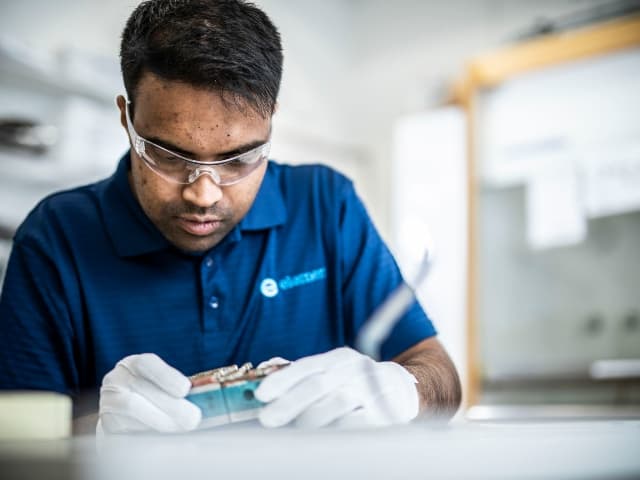Wireless Coexistence Testing
Ensure flawless performance of your wireless-enabled medical, consumer and industrial devices even in today's crowded wireless environments. Our comprehensive Wireless Coexistence Testing helps you achieve global compliance while maintaining reliable functionality. As your single-source testing and certification partner, we provide fast and reliable market access to 161+ countries, simplifying the testing and compliance journey, and offer guidance from concept to market access and beyond.

What is Wireless Coexistence Testing at Element?
Wireless coexistence testing evaluates how multiple electronic devices interact and perform within shared wireless environments. As wireless technologies advance and the number of wirelessly connected products increases exponentially, this testing becomes critical. At Element, we provide comprehensive assessment services that measure your product's ability to function effectively alongside other wireless technologies, from smart phones to medical devices, identifying potential interference issues that could impact performance and critical safety functions.

What Can Element Offer You For Wireless Coexistence Testing?
Key Tests Offered
Key Tests Offered
At Element, we work with you throughout the testing process to perform thorough, comprehensive wireless coexistence testing that evaluates product performance in high-volume, crowded environments. Our methodology follows industry-recognized standards like ANSI C63.27 and AIM 7351731. We conduct compatibility, susceptibility, and immunity testing to thoroughly assess performance in high-volume environments. These tests identify potential interference issues, measure operational integrity under various conditions, and provide actionable insights for product improvement.
- Wireless Coexistence Testing Services
- Compatibility with other wireless systems
- Susceptibility to interference
- Immunity testing
- Risk assessment for medical applications
Products We Test
Products We Test
We specialize in testing a wide range of wireless-enabled products across medical, consumer, transportation, and industrial sectors. Our expertise extends from life-critical medical devices requiring stringent verification to consumer electronics operating in crowded wireless environments. We test complete systems as well as individual components to ensure each element of your wireless ecosystem performs reliably under real-world conditions.
- Medical devices
- Consumer electronics and household appliances
- Industrial equipment
- Automotive systems and components
- Aerospace systems and components
- Defense systems
- Multi-device wireless systems
- IoT devices and networks
Methods And Solutions Offered
Methods And Solutions Offered
We partner with you throughout the testing process to ensure your wireless products meet all performance and regulatory requirements. Our Early Stage Qualification (ESQ) provides test planning services that help you design with certification in mind. We develop custom testing protocols to replicate real-world scenarios, offer detailed performance analysis, and provide recommendations to optimize your product design and mitigate risks. Our trusted approach helps ensure fast and efficient access to your target markets.
- ANSI C63.27 test methodologies
- AIM 7351731 testing procedures
- Custom test environment creation
- Early Stage Qualification (ESQ)
- Design optimization recommendations
Medical device regulatory expertise
Our specialized team understands the unique challenges faced by medical device manufacturers. We provide comprehensive support for FDA and MDR requirements and international standards compliance, helping you navigate the complex regulatory landscape for wireless medical technology. Our expertise extends beyond testing to include risk management guidance and documentation support throughout your product development cycle.
- FDA regulatory compliance support
- Medical device safety assessment
- International standards expertise
- Risk management guidance
- Complete documentation assistance
Cutting-Edge Equipment We Use
Cutting-Edge Equipment We Use
Our state-of-the-art laboratories are equipped with specialized testing environments and tools designed to accurately measure wireless performance and coexistence capabilities. We maintain calibrated test chambers that can simulate various wireless conditions and interference scenarios, allowing us to provide reliable, repeatable test results that accurately predict real-world performance.
- Specialized RF testing chambers
- Signal measurement equipment
- Environmental simulation tools
- Interference generation systems
- Data acquisition and analysis platforms
Which Labs Offer This Service
Which Labs Offer This Service
Element operates dedicated, full-service EMC, radio, and safety testing facilities throughout the US, Europe and Asia. Our strategically located laboratories enable convenient access to expert testing services, regardless of your location. Each facility is staffed with wireless specialists who understand both the technical and regulatory aspects of wireless coexistence testing.
Standards we test to and products we test
Standards we test to include ANSI C63.27 and AIM 7351731.
Our independent certification services can support you with fast and efficient access to your target markets:
- UKCA Marking
- Radio Equipment Directive (RED)
- Global market access to over 161 countries
Medical devices
- Wireless-enabled medical equipment
- Home healthcare equipment
- Wearable medical devices
- Medical robotics
- Implantable devices
- Medical monitoring devices
- Remote healthcare technology
- Patient data transmission systems
Consumer electronics
- Matter-enabled consumer devices and appliances
- IoT consumer devices
- Household appliance
- Wearable devices
- Cellular devices & smart phones
Industrial devices
- Industrial radio products
- Wireless industrial equipment
Wireless Transportation technologies
- Automotive electronics and systems
- Aerospace electronics and systems
- Defense electronics and systems
Your Challenges, Our Solutions
Performance in crowded environments
Complex regulatory compliance process
Interference risks for safety-critical devices
Testing failures requiring costly redesigns
Why Choose Element

Global testing network
Medical device specialty
Comprehensive certification support
Early design collaboration
Frequently asked questions
How does wireless coexistence impact medical device safety?
As wireless device usage increases, interference risks grow, potentially affecting safety-critical functions in medical devices. Comprehensive wireless coexistence testing helps identify these risks early, allowing manufacturers to implement mitigations that ensure products remain safe and effective for patients even in crowded wireless environments.

Explore our global network of labs and find your nearest location
VIEW ALL LOCATIONSRelated services

Transportation Testing Services
Access century-proven transportation testing services with Element's global laboratory network. From marine and rail to automotive and autonomous systems, we ensure your products meet regulations with faster turnaround times and hands-on expert partnership.

Wireless Device Testing & Certification
Get your wireless devices to market faster with Element's accredited testing services. Expert guidance through compliance, certification and global approvals for all wireless technologies.

General Product Safety Regulation (EU) 2023/988 (GPSR) Testing Services
At Element, we help your products meet the safety requirements of the General Product Safety Regulation (GPSR). With comprehensive testing, advisory services, and Notified Body support, we guide you through compliance, reducing time to market and ensuring consumer trust.

Wireless Medical Device Testing Services
Accelerate your wireless medical device’s journey to market with Element's comprehensive testing solutions. From remote patient-monitoring systems to IoT-enabled devices – Learn More.

